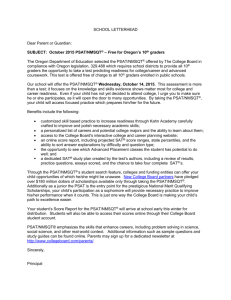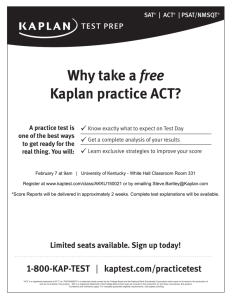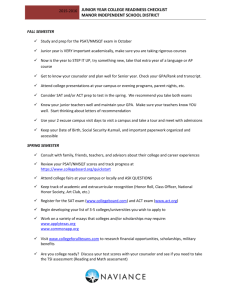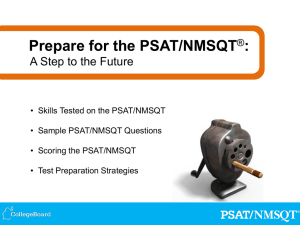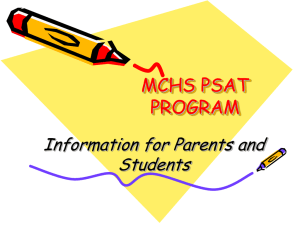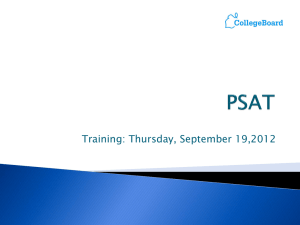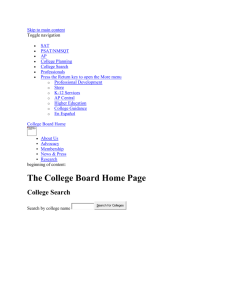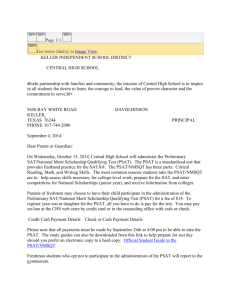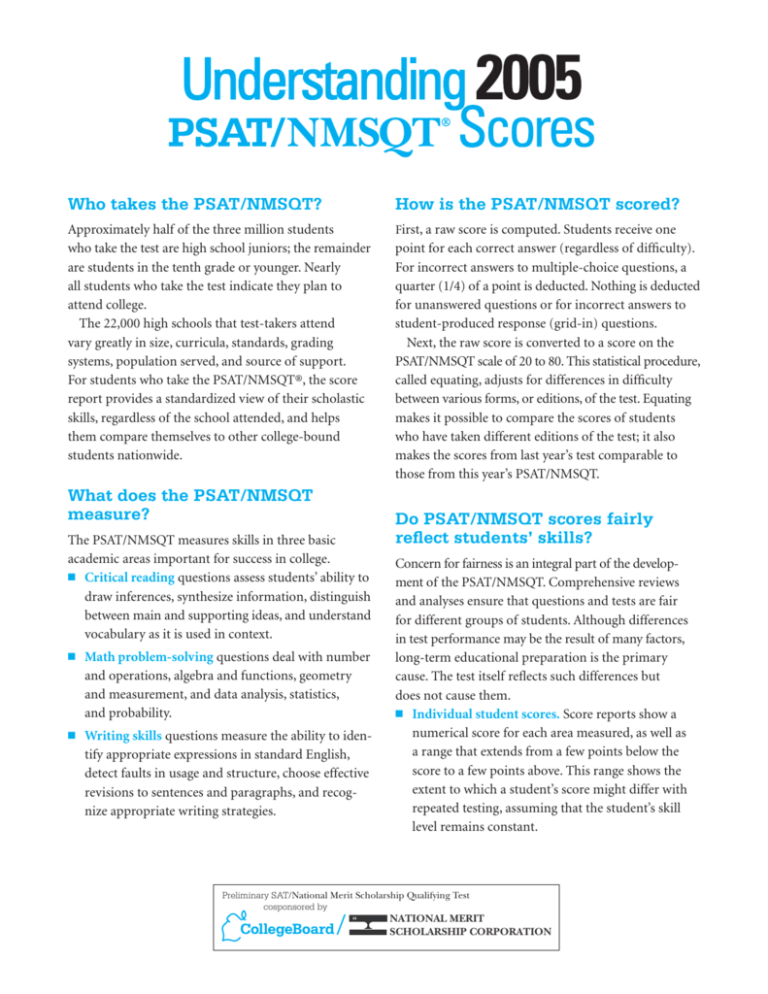
Who takes the PSAT/NMSQT?
How is the PSAT/NMSQT scored?
Approximately half of the three million students
who take the test are high school juniors; the remainder
are students in the tenth grade or younger. Nearly
all students who take the test indicate they plan to
attend college.
The 22,000 high schools that test-takers attend
vary greatly in size, curricula, standards, grading
systems, population served, and source of support.
For students who take the PSAT/NMSQT®, the score
report provides a standardized view of their scholastic
skills, regardless of the school attended, and helps
them compare themselves to other college-bound
students nationwide.
First, a raw score is computed. Students receive one
What does the PSAT/NMSQT
measure?
The PSAT/NMSQT measures skills in three basic
academic areas important for success in college.
䡲 Critical reading questions assess students’ ability to
draw inferences, synthesize information, distinguish
between main and supporting ideas, and understand
vocabulary as it is used in context.
䡲 Math problem-solving questions deal with number
and operations, algebra and functions, geometry
and measurement, and data analysis, statistics,
and probability.
䡲 Writing skills questions measure the ability to identify appropriate expressions in standard English,
detect faults in usage and structure, choose effective
revisions to sentences and paragraphs, and recognize appropriate writing strategies.
point for each correct answer (regardless of difficulty).
For incorrect answers to multiple-choice questions, a
quarter (1/4) of a point is deducted. Nothing is deducted
for unanswered questions or for incorrect answers to
student-produced response (grid-in) questions.
Next, the raw score is converted to a score on the
PSAT/NMSQT scale of 20 to 80. This statistical procedure,
called equating, adjusts for differences in difficulty
between various forms, or editions, of the test. Equating
makes it possible to compare the scores of students
who have taken different editions of the test; it also
makes the scores from last year’s test comparable to
those from this year’s PSAT/NMSQT.
Do PSAT/NMSQT scores fairly
reflect students’ skills?
Concern for fairness is an integral part of the development of the PSAT/NMSQT. Comprehensive reviews
and analyses ensure that questions and tests are fair
for different groups of students. Although differences
in test performance may be the result of many factors,
long-term educational preparation is the primary
cause. The test itself reflects such differences but
does not cause them.
䡲 Individual student scores. Score reports show a
numerical score for each area measured, as well as
a range that extends from a few points below the
score to a few points above. This range shows the
extent to which a student’s score might differ with
repeated testing, assuming that the student’s skill
level remains constant.
1SFMJNJOBSZ4"5.ATIONAL-ERIT3CHOLARSHIP1UALIFYING4EST
DPTQPOTPSFECZ
.!4)/.!,-%2)4
3#(/,!23()0#/20/2!4)/.
䡲 Differences between students. When comparing
scores between students for the same measure (critical reading, math, writing skills), you can determine
true differences in scores by using the standard
error of the difference (SED). Differences of fewer
than 8 points (or 1.5 SED) are not significant, while
differences of 8 points or more are likely to reflect
true differences in scores.
What is reported in the “Improve
Your Skills” section of the score
report?
The “Improve Your Skills” section of Score Report
Plus gives students a personalized analysis of their areas
of weakness as well as specific suggestions for how to
improve. This information is derived from analyzing
individual performance across test questions. Each test
question contains a different combination of skills.
Based on a student’s individual performance across the
questions, the score report notes up to three skills each
in critical reading and math and up to two writing skills
in which the student needs to improve. Also referenced
are test questions that contain the skills and that the
student answered incorrectly. See the complete list of
skills on pages 11–12.
Are the reported skills the
student’s weakest areas?
Not necessarily. Score Report Plus gives highest
priority to those skills that appear most attainable.
This approach gives students a better opportunity to
improve, rather than overwhelming them with their
shortcomings. For students who are weak in more than
three critical reading skills, for example, the three in
which they have the best chance to improve with extra
work are reported. The educational importance of the
skills, determined with the advice of panels of expert
educators, also plays a role in the selection.
2
Can PSAT/NMSQT scores be used
to estimate SAT® scores?
PSAT/NMSQT critical reading, math, and writing
skills questions are designed to be the same as those
on the SAT Reasoning Test™. This is deliberate, as the
PSAT/NMSQT questions are intended to be reliable
practice for the same types of questions on the SAT®.
The PSAT/NMSQT scale of 20 to 80 is equivalent to
the SAT scale of 200 to 800.
Estimated SAT score ranges are included on student
score reports. Two times out of three, students earn
SAT scores within these ranges, but actual scores may
be higher (or lower) than these estimates. (As SAT
writing scores also include an essay, there will be more
variability in the estimates of those scores.) Higher
than estimated SAT scores may result from intervening
activities, such as
䡲 developing skills through rigorous academic
courses;
䡲 participating in problem-solving activities;
䡲 extensive, quality outside reading and/or writing;
䡲 following the advice in the “Improve Your Skills”
section on Score Report Plus; or
䡲 becoming more familiar with test directions, types
of questions, and pacing.
Juniors frequently take the SAT 6 or 7 months
after taking the PSAT/NMSQT. Estimated SAT
scores assume the SAT is taken within a year of the
PSAT/NMSQT. Sophomores may not take the SAT
for 18 months, providing a greater opportunity for
intervening activities to influence their SAT scores.
What PSAT/NMSQT reports do
schools receive?
The following basic reports are provided to all schools:
䡲 PSAT/NMSQT Score Report Plus for each student
tested (one for the student and one for the school)
䡲 Score Labels, summarizing the basic score information
(one set of labels)
How should schools use
䡲 Roster of Student Scores and Plans, listing studentreported information and scores for each student,
as well as important access codes for different online
tools for educators
The PSAT/NMSQT is intended to help students evaluate
skill levels in three critical academic areas; prepare
for the SAT; compare their readiness for college-level
work with that of their peers; and enter scholarship
competitions. Score reports should be used for counseling
students about educational plans.
PSAT/NMSQT scores are not for use by colleges as
part of their admission criteria. Scores should not be
included on student transcripts that will be reproduced
and sent to colleges unless the student (age 18 or older)
or parent/guardian has granted permission. Inform
students of their right to withhold these scores from
admission or athletic offices, even when requested.
䡲 School Summary Report (provided if at least 50
of a school’s juniors or sophomores tested at the
school), summarizing score statistics and studentreported information
䡲 Summary Statistics Report with summary score
data for each grade in which 25 or more students
of the same sex tested
The following reports are available online on
www.collegeboard.com/reports.
䡲 AP Potential™, a Web-based tool that helps schools
identify more students with the potential for success
in Advanced Placement Program® (AP®) courses
䡲 PSAT/NMSQT Summary Report: National,
Regional, and State Data, providing score statistics
and student-reported information for juniors and
sophomores, including final mean scores. Reports
for 2005 will be available in the spring of 2006.
䡲 Summary of Answers and Skills, aggregating student responses to each test question and providing
information on skills that need improvement
Several optional reports are available for a fee:
䡲 Special Summary Report, summarizing score
data for schools that test fewer than 50 juniors/50
sophomores, or for schools that have some juniors
or sophomores who tested elsewhere
PSAT/NMSQT score reports?
Questions?
Visit www.collegeboard.com/counselors/psat for
additional data relevant to the test. Or contact the
PSAT/NMSQT program at:
Mail:
P.O. Box 6720, Princeton, NJ 08541-6720
Phone: 888 477-PSAT (7728) (for educators only)
609 771-7070
8 a.m. to 4 p.m. eastern time
Fax:
609 530-0482
E-mail: PSAT@info.collegeboard.org
Plan Ahead for
2006 PSAT/NMSQT Dates
Wednesday, October 18, 2006 • Saturday, October 21, 2006
䡲 System Summary Report, combining score data
from all schools in a system
䡲 Electronic Data Reports, including all studentprovided data as well as scores and skills (in disk
format)
To order, visit www.collegeboard.com/school.
3
PSAT/NMSQT Percentiles and Mean Scores
can be used to compare students’ performance with that of juniors and sophomores.
Points to Note
䡲 Percentiles indicate the percentage
of students whose scores fall below
each specified score.
䡲 On the score report, percentiles
for juniors compare their performance with that of other juniors
who took the test. For sophomores
or younger students, percentiles
compare their performance with
that of sophomores.
䡲 Percentiles are based on the critical
reading, math, and writing skills
scores earned by a sample of
college-bound juniors or sophomores who took the PSAT/NMSQT
in 2005.
䡲 The mean score is the statistic that
describes the average performance
of a group.
䡲 The standard deviation is a measure
of the variability of a set of scores
around their mean. If the test scores
cluster tightly around the mean
score, as they do when the group
tested is relatively homogeneous,
the standard deviation is smaller
than it would be for a more
diverse group.
Reliability
shows how consistently students would
earn similar scores in repeated testings.
Reliability
Coefficient
Average
SEM
0.87
0.89
0.85
3.9
3.7
4.0
Critical Reading
Math
Writing Skills
Points to Note
Data are based on a sample of sophomores and
juniors who took the PSAT/NMSQT in the previous
year (2004 Wednesday and Saturday forms).
䡲 A reliability coefficient helps to show expected
fluctuation in scores if a student takes a test
more than once. The higher the reliability
coefficient, the smaller the fluctuation of scores
across repeated testings. A reliability coefficient
of 1.00 would indicate perfect reliability, or no
expected fluctuation.
䡲 PSAT/NMSQT scores should be interpreted as
ranges rather than points. The standard error of
measurement (SEM) in the table above indicates
that a student who took different forms of the
test under identical conditions would be likely
to earn scores within 4 points of one another.
4
Selection Index Percentiles and Mean Score
can be used to compare students’ performance with that of juniors.
Points to Note
䡲 Reported on a scale ranging from 60 to 240, the
Selection Index is the sum of the critical reading,
math, and writing skills scores. For example, a
critical reading score of 56, a math score of 62,
and a writing skills score of 59 would result in
a Selection Index of 177 (56 + 62 + 59).
䡲 Percentiles are based on the Selection Index earned
by a sample of college-bound juniors who took
the PSAT/NMSQT in 2005.
How NMSC Uses the Selection
Index
National Merit Scholarship Corporation (NMSC)
uses the Selection Index score as an initial screen
of the 1.3 million test-takers who meet program
entry requirements and to designate groups of
students to receive recognition in the programs it
conducts. Participation in NMSC’s competitions
for scholarships to be offered in 2007 is determined
by students’ responses to the four program entry
questions on the 2005 PSAT/NMSQT answer sheet.
Both the PSAT/NMSQT Score Report Plus and
the Roster of Student Scores and Plans show the
student’s Selection Index, the student’s responses
to the entry items, and whether the student meets
participation requirements.
Of the more than one million NMSC program
entrants, about 55,000 will earn 2005 PSAT/NMSQT
scores high enough to qualify them for recognition.
These students will be notified of their standing
through their high schools in September 2006. Students
who qualify to continue in the competitions for
scholarships to be offered in 2007 then must meet
academic and other requirements specified by NMSC
to be considered for awards.
Detailed descriptions of NMSC programs are
published in the Guide to the National Merit®
Scholarship Program and the National Achievement®
Scholarship Program Information Booklet, mailed to
high school principals each fall. For students and
parents, information about the competitions is given
in the PSAT/NMSQT Official Student Guide and at
www.nationalmerit.org.
Inquiries about any aspect of the National Merit
Program or National Achievement Program—
including entry requirements, the selection process,
and awards to be offered—should be sent to
National Merit Scholarship Corporation, 1560
Sherman Avenue, Suite 200, Evanston, IL 60201-4897;
5
telephone 847 866-5100.
2005 PSAT/NMSQT Score Conversion Tables
show how points obtained on the test are converted to scores on the 20–80 PSAT/NMSQT scale.
Points to Note
䡲 Points represent the total number of
correct answers minus a quarter (1/4)
of a point for each incorrect answer
to a multiple-choice question.
䡲 Nothing is deducted for incorrect
answers to student-produced
response questions or for omitted
answers of any type.
䡲 Points are totaled, then converted
to scores on the 20–80 PSAT/NMSQT
scale.
䡲 Converting points to scores adjusts
for slight differences in difficulty
between various forms. A statistical
process called equating adjusts
for these small differences. This
ensures that a score of, say, 65 on
one form of the test reflects a similar
level of performance as does a 65
on another form of the test.
䡲 There is no advantage or disadvantage
in taking either the Wednesday or the
Saturday test form.
7
PSAT/NMSQT Score Change from Sophomore to Junior Year
shows how scores change for students who take the PSAT/NMSQT as sophomores and again as juniors.
Table 1
Points to Note
䡲 The left-hand column of this
table groups sophomores by
critical reading, math, and
writing skills score ranges on
the PSAT/NMSQT. Columns
to the right show the percentage of students who gained or
lost points when they took the
test the following year. The far
right column shows the average junior-year PSAT/NMSQT
score of each original group
of sophomores who had taken
the PSAT/NMSQT.
䡲 On average, students taking the
PSAT/NMSQT as sophomores
and again as juniors have
junior-year PSAT/NMSQT
scores that are 3.3 points
higher in critical reading,
4.4 points higher in math,
and 4.1 points higher in
writing. However, these are
averages: some students earn
scores in their junior year
that are significantly higher;
others receive lower scores.
䡲 Of students who took the
PSAT/NMSQT as sophomores
and again as juniors, 69% had
junior-year PSAT/NMSQT
critical reading scores that
were higher, 6% of the scores
stayed the same, and 25% were
lower; 76% had junior-year
PSAT/NMSQT math scores
that were higher, 5% of the
scores stayed the same, and
19% were lower; 71% had
junior-year PSAT/NMSQT
writing skills scores that were
higher, 5% of the scores stayed
the same, and 24% were lower.
䡲 Several factors can influence
the amount that scores will
change, such as a student’s
academic course work and
outside reading.
Percentage of Junior-Year Students with a Score Gain or Loss after Taking the PSAT/NMSQT
in Their Sophomore Year and Again in Their Junior Year.
CRITICAL READING
SophomoreYear
PSAT/
NMSQT
Scores
68-72
+14
&
above
Average of
Junior-Year
PSAT/NMSQT
Scores
-14 &
below
-11
to
-13
-8
to
-10
-5
to
-7
-2
to
-4
-1
to
+1
+2
to
+4
+5
to
+7
+8
to
+10
+11
to
+13
1
1
4
12
16
25
16
13
9
2
63-67
1
3
8
17
24
21
13
8
4
1
66
58-62
1
2
6
16
22
24
17
7
4
2
62
53-57
1
2
5
12
21
24
18
11
4
2
57
48-52
1
2
5
10
18
22
22
13
5
2
53
70
43-47
1
1
2
5
11
17
20
19
14
7
3
48
38-42
1
1
2
5
10
15
20
19
14
8
5
44
33-37
1
2
3
5
8
14
20
19
14
8
6
39
1
4
7
7
12
15
18
16
10
9
35
-11
to
-13
-8
to
-10
-5
to
-7
-2
to
-4
-1
to
+1
+2
to
+4
+5
to
+7
+8
to
+10
+11
to
+13
+14
&
above
Average of
Junior-Year
PSAT/NMSQT
Scores
1
28-32
MATH
SophomoreYear
PSAT/
NMSQT
Scores
-14 &
below
68-72
2
7
17
22
18
18
9
6
63-67
1
5
10
24
24
15
10
5
3
71
68
58-62
1
5
10
19
25
21
11
5
4
64
53-57
1
3
9
17
23
21
15
7
3
59
48-52
1
3
8
15
22
22
16
8
4
54
43-47
1
3
8
16
20
20
17
9
5
50
38-42
1
1
2
4
7
14
21
22
14
10
6
45
33-37
1
1
1
4
8
12
16
21
17
10
8
40
1
2
3
6
12
16
16
17
13
12
36
-8
to
-10
-5
to
-7
-2
to
-4
-1
to
+1
+2
to
+4
+5
to
+7
+8
to
+10
+11
to
+13
+14
&
above
Average of
Junior-Year
PSAT/NMSQT
Scores
28-32
WRITING SKILLS
SophomoreYear
PSAT/
NMSQT
Scores
-14 &
below
-11
to
-13
68-72
1
2
4
9
13
13
22
17
13
6
63-67
1
2
4
7
12
19
10
18
15
8
5
68
58-62
1
71
1
3
7
12
14
20
16
8
11
8
64
53-57
1
2
6
12
15
19
14
15
7
8
59
48-52
1
2
5
9
15
21
16
15
8
9
54
43-47
1
2
5
10
15
19
19
14
8
7
49
1
6
11
16
19
18
14
8
6
44
2
9
19
21
19
14
9
7
41
1
7
22
24
20
13
14
39
38-42
33-37
28-32
Data are based on 518,906 students who took the PSAT/NMSQT as sophomores in
October 2003 and as juniors in October 2004.
9
Score Change from PSAT/NMSQT to SAT
shows how scores change for students who take the PSAT/NMSQT in October and the
SAT Reasoning Test the following spring.
Points to Note
Table 2
Percentage of Junior-Year Students with a Score Gain or Loss Between the PSAT/NMSQT in October
and the SAT the Following Spring.
䡲 The PSAT/NMSQT reports
scores on a scale from 20 to 80.
Scores on the SAT are reported CRITICAL READING
on a 200-to-800 scale.
Junior-Year
Average of
䡲 The left-hand column of this
-110 -80 -50 -20 -10 +20 +50 +80
+110
+140
PSAT/
Junior-Year
table groups juniors by score
to
to
to
to
to
to
to
to
to
&
-140 &
NMSQT
SAT Scores
ranges on the PSAT/NMSQT.
Scores
below -130 -100 -70 -40 +10 +40 +70 +100 +130 above
Columns to the right show
68-72
1
1
3
9
17
23
21
13
8
4
709
the percentage of students
63-67
1
2
7
15
23
23
16
9
3
1
668
who gained or lost points
58-62
1
2
6
14
22
23
18
9
4
2
620
when they took the SAT the
53-57
1
1
2
7
14
22
24
17
9
3
1
569
following spring. The far right
48-52
1
2
6
13
22
24
18
9
3
1
521
column shows the average SAT
score for the group of juniors
43-47
1
2
5
12
21
24
19
11
4
2
476
in each score range.
38-42
1
1
2
4
10
18
23
21
13
5
2
433
䡲 On average, juniors taking
33-37
1
1
2
4
8
14
20
22
16
8
4
394
the PSAT/NMSQT in October
28-32
1
2
3
6
10
16
21
19
13
9
361
and the SAT the following
MATH
spring have SAT scores that
are 25 points higher in critical
Junior-Year
Average of
reading and 19 points higher
-110 -80 -50 -20 -10 +20 +50 +80
+110
+140
PSAT/
Junior-Year
in math (equivalent to 2.5 and
to
to
to
to
to
to
to
to
to
&
-140 &
NMSQT
SAT Scores
1.9 points, respectively, on the
Scores
below -130 -100 -70 -40 +10 +40 +70 +100 +130 above
PSAT/NMSQT scale). Data for
68-72
1
2
8
20
27
22
11
7
2
696
writing are not available.
63-67
1
1
2
7
16
26
25
15
6
2
1
658
䡲 Of PSAT/NMSQT test-takers
58-62
1
1
2
7
14
23
25
17
7
2
1
612
who took the SAT in the
53-57
1
3
7
14
21
23
17
10
3
1
567
spring, 65% had SAT critical
48-52
1
2
7
14
21
23
17
10
4
1
521
reading scores that were higher,
43-47
1
2
6
13
21
23
18
10
4
2
476
7% of the scores stayed the
same, and 28% were lower;
38-42
1
1
2
5
12
20
23
18
10
5
2
427
61% had SAT math scores that
33-37
1
1
2
5
10
16
21
21
14
6
3
385
were higher, 7% of the scores
28-32
1
3
4
7
13
17
21
17
11
6
351
stayed the same, and 32% were
lower than their corresponding WRITING
PSAT/NMSQT scores.
Junior-Year
Average of
䡲 Relatively low PSAT/NMSQT
-110 -80 -50 -20 -10 +20 +50 +80
+110
+140
PSAT/
Junior-Year
scores are followed by larger
to
to
to
to
to
to
to
to
to
&
-140 &
NMSQT
SAT Scores
average gains than are relatively
Scores
below -130 -100 -70 -40 +10 +40 +70 +100 +130 above
high PSAT/NMSQT scores.
68-72
䡲 Several factors can influence
63-67
the amount that scores will
58-62
change, such as a student’s
The writing score-change table will be provided when there
53-57
academic course work and
is
sufficient historical context to substantiate the relationship
48-52
outside reading.
with the new SAT writing score.
43-47
38-42
33-37
28-32
Data for the critical reading and math scores are based on 568,212 students who took the
PSAT/NMSQT as juniors in October 2004 and the SAT as juniors in spring 2005.
10
PSAT/
NMSQT
®
Score Report Plus Skills List
Critical Reading Skills
CR1 Understanding main ideas in a reading
passage
How to improve: Read the passage carefully and try to determine
the author’s overall message. Practice making distinctions
between the main idea and supporting details.
CR2 Understanding tone
How to improve: When reading, consider how an author’s
choice of words helps define his or her attitudes. Pay attention
to the way in which tone conveys meaning in conversation
and in the media.
CR3 Comparing and contrasting ideas presented
in two passages
How to improve: Read editorials that take opposing views on
an issue. Look for differences and similarities in tone, point
of view, and main idea.
CR4 Understanding the use of examples
How to improve: Authors often include examples in their
writing to communicate and support their ideas. Read different kinds of argumentative writing (editorials, criticism,
personal essays) and pay attention to the way examples are
used. State the point of the examples in your own words.
Use examples in your own writing.
CR5 Recognizing the purpose of various writing
strategies
How to improve: Writers use a variety of tools to achieve
their effects. While you read, look for such things as specific
examples, quotations, striking images, and emotionally
loaded words. Think about the connotations of specific
words and why the author might have decided to use them.
CR6 Applying ideas presented in a reading
passage
How to improve: When you read, try to determine the
author’s ideas and assumptions and then think about how
they might apply to new situations.
CR7 Determining an author’s purpose or
perspective
How to improve: Authors write for a variety of purposes,
such as to inform, to explain, or to convince. When you read,
try to determine why the author wrote what he or she wrote.
CR8 Making connections between information in
different parts of a passage
How to improve: Work on figuring out the relationship
between the material presented in one part of a reading passage
and material presented in another part. Ask yourself, for
example, how facts presented in the beginning of a magazine
article relate to the conclusion.
CR9 Distinguishing conflicting viewpoints
How to improve: When reading, practice summarizing
main ideas and noting sentences that mark transition points.
Learn to understand methods of persuasion and argumentation.
Expand your reading to include argumentative writing, such
as political commentary, philosophy, and criticism.
CR10 Being thorough
How to improve: Don’t just pick the first answer choice you
see that looks tempting. Be sure to evaluate all the choices
before you select your answer, just as you would read an
entire paragraph rather than assume its meaning based
only on the first sentence.
CR11 Understanding difficult vocabulary
How to improve: Broaden your reading to include newspapers
and magazines, as well as fiction and nonfiction from before
the 1900s. Include reading material that is a bit outside your
comfort zone. Improve your knowledge of word roots to
help determine the meaning of unfamiliar words.
CR12 Understanding how negative words,
suffixes, and prefixes affect sentences
How to improve: When reading, pay attention to the ways in
which negative words (like “not” and “never”), prefixes (like
“un” and “im”), and suffixes (like “less”) affect the meaning
of words and sentences.
CR13 Understanding complex sentences
How to improve: Ask your English teacher to recommend
books that are a bit more challenging than those you’re used
to reading. Practice breaking down the sentences into their
component parts to improve your comprehension. Learn
how dependent clauses and verb phrases function
in sentences.
CR14 Recognizing connections between ideas in
a sentence
How to improve: Learn how connecting words (such as
relative pronouns and conjunctions) establish the relationship between different parts of a sentence.
CR15 Recognizing words that signal contrasting
ideas in a sentence
How to improve: Learn how certain words (such as “although,”
“but,” “however,” and “while”) are used to signal a contrast
between one part of a sentence and another.
CR16 Recognizing a definition when it is
presented in a sentence
How to improve: Learn how such elements as appositives,
subordination, and punctuation are used to define words in
a sentence.
CR17 Understanding sentences that deal with
abstract ideas
How to improve: Broaden your reading to include newspaper
editorials, political essays, and philosophical writings.
CR18 Understanding and using a word in an
unusual context
How to improve: Work on using word definitions when
choosing an answer. Try not to be confused by an unusual
meaning of a term.
CR19 Comprehending long sentences
How to improve: Practice reducing long sentences into
small, understandable parts.
CR20 Choosing a correct answer based on the
meaning of the entire sentence
How to improve: Make sure your answer choice fits the
logic of the sentence as a whole. Don’t choose an answer
just because it sounds good when inserted in the blank.
CR21 Understanding sentences that deal with
scientific ideas
How to improve: Read magazine articles about scientific
subjects to improve your comfort level in this area.
11
Math Skills
Writing Skills
M1 Using basic concepts and operations in
arithmetic problem solving
How to improve: Practice solving problems involving positive
and negative integers, fractions, decimals, ratio, percent,
exponents, square roots, place value, and digits. Also practice
solving problems involving odd and even integers, prime
numbers, multiples, divisibility, and remainders.
M2 Understanding geometry and coordinate
geometry
How to improve: Review geometry units in your textbook
involving perimeter, area, volume, circumference, angles,
lines, and slope. Familiarize yourself with the formulas
given at the beginning of math sections of the test.
M3 Dealing with probability, basic statistics,
charts, and graphs
How to improve: Practice solving problems that involve
basic probability, basic counting, and finding the average
(arithmetic mean), median, and mode. Look for charts and
graphs in newspapers and magazines, and practice interpreting the data in them.
M4 Creating either figures or algebraic
equations, inequalities, or expressions to
help solve problems
How to improve: Practice solving problems by drawing
or visualizing figures to help you understand the problem.
Practice developing equations, inequalities, or expressions
from verbal descriptions, figures, or numerical data.
M5 Using basic algebraic concepts and operations
to solve problems
How to improve: Review algebraic concepts and rules, such
as those involving substitution, exponents, solving equations
and inequalities, and combining algebraic expressions.
M6 Making connections among mathematical
topics
How to improve: Practice problems that require combining
skills acquired in different math courses, such as problems
that use combinations of arithmetic, algebra, and geometry.
M7 Organizing and managing information to
solve multistep problems
How to improve: Write down your steps in solving the
problem. Monitor the steps as you go along, keeping in
mind what the question is asking.
M8 Using logical reasoning
How to improve: Practice solving problems in which you
must consider different possible cases. Make adjustments in
your solution strategy when things aren’t going as well as
they should. It may help to look at the problem from different
perspectives. Solving problems that require you to justify
your answers may help you develop this skill.
M9 Recognizing patterns and equivalent forms
How to improve: Try recognizing a pattern by considering
a simpler case. Try rewriting or rearranging the given expressions in a different form.
M10 Recognizing logical key words
How to improve: Pay attention to key words, such as “not,”
“at least,” “at most,” “must be,” “could be,” “possible,” and
“different.” These words determine the meaning of the
question and therefore must be understood to correctly
solve the problem.
M11 Using answer choices to help solve the problem
How to improve: Looking at the answer choices may help
you understand the problem. Sometimes the choices can
help identify a strategy for solving the problem.
W1 Being precise and clear
How to improve: Learn to recognize sentence elements that
are ambiguous and confusing. In your writing, choose words
carefully and connect them for clear meaning.
W2 Following conventions in writing
How to improve: Review the chapters in a grammar book
that cover grammatical conventions, such as word choice,
use of noun and prepositional phrases, and sentence
construction. Work with your teacher to become more
familiar with the conventions of standard written English.
W3 Recognizing logical connections within
sentences and passages
How to improve: Use the writing process to help you revise
your draft essays. Work with classmates and teachers to
clarify meaning in your writing.
W4 Using verbs correctly
How to improve: Make sure that you can identify the subject
and verb of a sentence. Make sure you understand subject
and verb agreement.
W5 Recognizing improper pronoun use
How to improve: Learn to understand the distinction
between informal, spoken pronoun usage and standard
written pronoun usage. Review the way you use pronouns
in your own writing. Ask your teacher to help you identify
and correct pronoun errors in your own writing.
W6 Understanding the structure of sentences
with unfamiliar vocabulary
How to improve: Read material that contains unfamiliar
vocabulary. Look for context clues to help you guess at the
meaning of unfamiliar words as you read.
W7 Understanding complicated sentence
structures
How to improve: Refer to a grammar book to identify
various sentence patterns and their effective use. Vary the
sentence patterns in your own writing.
W8 Understanding the structure of long
sentences
How to improve: As you read, break long sentences into
smaller units of meaning.
W9 Understanding the structure of sentences
with abstract ideas
How to improve: Read newspapers, magazines, and books
that deal with subjects such as politics, economics, history,
or philosophy.
W10 Understanding the structure of sentences
that relate to science or math
How to improve: Focus on how something is said as well as
on what is said. Write about the things you are learning in
math and science classes. Read articles in the science section
of newspapers and magazines so that you will feel more
comfortable with scientific or math content.
W11 Understanding the structure of sentences
that relate to the arts
How to improve: Focus on how something is said as well as
on what is said. Read articles in newspapers and magazines
about the arts so that you will feel more comfortable with
these subjects.
© 2005 The College Board. All rights reserved. College Board, AP, Advanced Placement Program, SAT, and the acorn logo are registered trademarks of the College Board. AP
Potential and SAT Reasoning Test are trademarks owned by the College Board. PSAT/NMSQT is a registered trademark of the College Board and National Merit Scholarship
Corporation. Permission is hereby granted to any nonprofit school to reproduce this publication in whole or in part in limited quantities for distribution to students, parents,
and staff, but not for sale, provided that the copyright notice appears on all reproduced materials.
00274-02079 • Unlocked PDF 125
12
729782

